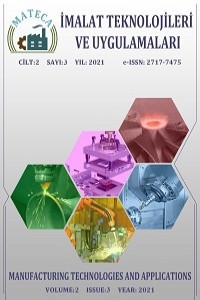Abstract
This study aims to investigate the effect of the addition of 40% by volume NiAl particles with different grain sizes to the pure Al matrix on the corrosion performance of the produced composites. NiAl particles used as reinforcement material were produced by arc melting method at a ratio of 1:1 by atom and turned into fine particles by mechanical grinding method. Afterwards, it was classified in different sizes by vibrating sieve and used in composite production. Thus, the effect of particle size on the corrosive properties of the produced composites was investigated. Production with pressure infiltration method was preferred in order to keep the reinforcement particle ratio high and to provide homogeneous distribution. The corrosive properties of the composites were determined by applying potentiodynamic polarization and dip corrosion test in 3.5% NaCl environment. In both test methods, it was observed that the corrosion resistance increased as the grain size decreased.
Keywords
Project Number
KBUBAP-18-YL-149
References
- A.Lekatou, A.E. Karantzalis, A. Evangelou, V. Gousia, G. Kaptay, Z. Gácsi, P. Baumli and A. Simon, Aluminium reinforced by WC and TiC nanoparticles (ex-situ) and aluminide particles (in-situ), Microstructure, wear and corrosion behaviour, Materials and Design, 65: 1121–1135 (2015).
- H. Çuğ and M. E. E. Erhaima, Effect of Mn and Zr Addition on Microstructure, Wear and Corrosion Behavior of Ti-6Al-4V Composite Biomaterials Produced by Powder Metallurgy, Manufacturing Technologies and Applications, 2 (2): 41-48 (2021).
- S. Candan, An investigation on corrosion behaviour of pressure infiltrated Al–Mg alloy/SiCp composites, Corrosion Science, 51: 1392–1398 (2009).
- K. H. W. Seah, M. Krishna, V. T. Vijayalakshmi and J. Uchil, Corrosion behaviour of garnet particulate reinforced LM13 Al alloy MMCs, Corrosion Science, 44: 917–925 (2002).
- S. Candan, Effect of SiC particle size on corrosion behavior of pressure infiltrated Al matrix composites in a NaCl solution, Mater Letters, 58(27-28): 3601–3605 (2004).
- ASTM G102-89, Standard practice for calculation of corrosion rates and related information from electrochemical measurements, ASTM International, 2004.
- ASTM G 31-72, Standard practice for laboratory immersion corrosion testing of metals, ASTM International, 1990.
- M. Conserva, G. Donzelli and R. Trippodo, Aluminum and Its Applications, Edimet, Brescia, 1992.
- B. Grushko, S. Mi, J.G. Highfield, A study of the Al-rich region of the Al–Ni–Mo alloy system, Journal of Alloys and Compounds, 334 (1-2): 187–191 (2002).
- A. Taylor and N. Doyle, Further studies on the nickel–aluminium system. I. βNiAl and δ-Ni2Al3 phase fields, Journal of Applied Crystallography, 5(3): 201–209 (1972).
- H. M. Zakaria, Microstructural and corrosion behavior of Al/SiC metal matrix composites, Ain Shams Engineering Journal, 5(3): 831-838 (2014).
Abstract
Bu çalışma saf Al matrise hacimce %40 oranında farklı tane boyutlarına sahip NiAl partikül ilavesinin, üretilen kompozitlerin korozyon performansına etkisini incelemeyi amaçlamaktadır. Takviye malzemesi olarak kullanılan NiAl partiküller ark ergitme yöntemi ile atomca 1:1 oranında üretilip mekanik öğütme yöntemi ile ince partiküller haline getirilmiştir. Sonrasında titreşimli elek ile farklı boyutlarda sınıflandırılarak kompozit üretiminde kullanılmıştır. Böylece partikül boyutunun üretilen kompozitlerin korozif özelliklerine etkisi incelenmiştir. Takviye partikül oranını yüksek tutmak ve homojen dağılım sağlamak için basınçlı infiltrasyon yöntemi ile üretim tercih edilmiştir. Kompozitlerin korozif özellikleri %3,5 NaCl ortamında potansiyodinamik polarizasyon ve daldırma korozyon testi uygulanarak belirlenmiştir. Her iki deney metodunda da tane boyutu düştükçe korozyon dayanımının arttığı gözlenmiştir.
Keywords
Supporting Institution
Karabük Üniveristesi
Project Number
KBUBAP-18-YL-149
References
- A.Lekatou, A.E. Karantzalis, A. Evangelou, V. Gousia, G. Kaptay, Z. Gácsi, P. Baumli and A. Simon, Aluminium reinforced by WC and TiC nanoparticles (ex-situ) and aluminide particles (in-situ), Microstructure, wear and corrosion behaviour, Materials and Design, 65: 1121–1135 (2015).
- H. Çuğ and M. E. E. Erhaima, Effect of Mn and Zr Addition on Microstructure, Wear and Corrosion Behavior of Ti-6Al-4V Composite Biomaterials Produced by Powder Metallurgy, Manufacturing Technologies and Applications, 2 (2): 41-48 (2021).
- S. Candan, An investigation on corrosion behaviour of pressure infiltrated Al–Mg alloy/SiCp composites, Corrosion Science, 51: 1392–1398 (2009).
- K. H. W. Seah, M. Krishna, V. T. Vijayalakshmi and J. Uchil, Corrosion behaviour of garnet particulate reinforced LM13 Al alloy MMCs, Corrosion Science, 44: 917–925 (2002).
- S. Candan, Effect of SiC particle size on corrosion behavior of pressure infiltrated Al matrix composites in a NaCl solution, Mater Letters, 58(27-28): 3601–3605 (2004).
- ASTM G102-89, Standard practice for calculation of corrosion rates and related information from electrochemical measurements, ASTM International, 2004.
- ASTM G 31-72, Standard practice for laboratory immersion corrosion testing of metals, ASTM International, 1990.
- M. Conserva, G. Donzelli and R. Trippodo, Aluminum and Its Applications, Edimet, Brescia, 1992.
- B. Grushko, S. Mi, J.G. Highfield, A study of the Al-rich region of the Al–Ni–Mo alloy system, Journal of Alloys and Compounds, 334 (1-2): 187–191 (2002).
- A. Taylor and N. Doyle, Further studies on the nickel–aluminium system. I. βNiAl and δ-Ni2Al3 phase fields, Journal of Applied Crystallography, 5(3): 201–209 (1972).
- H. M. Zakaria, Microstructural and corrosion behavior of Al/SiC metal matrix composites, Ain Shams Engineering Journal, 5(3): 831-838 (2014).
Details
| Primary Language | Turkish |
|---|---|
| Subjects | Composite and Hybrid Materials |
| Journal Section | Research Articles |
| Authors | |
| Project Number | KBUBAP-18-YL-149 |
| Early Pub Date | December 31, 2021 |
| Publication Date | December 31, 2021 |
| Submission Date | October 31, 2021 |
| Published in Issue | Year 2021 Volume: 2 Issue: 3 |

